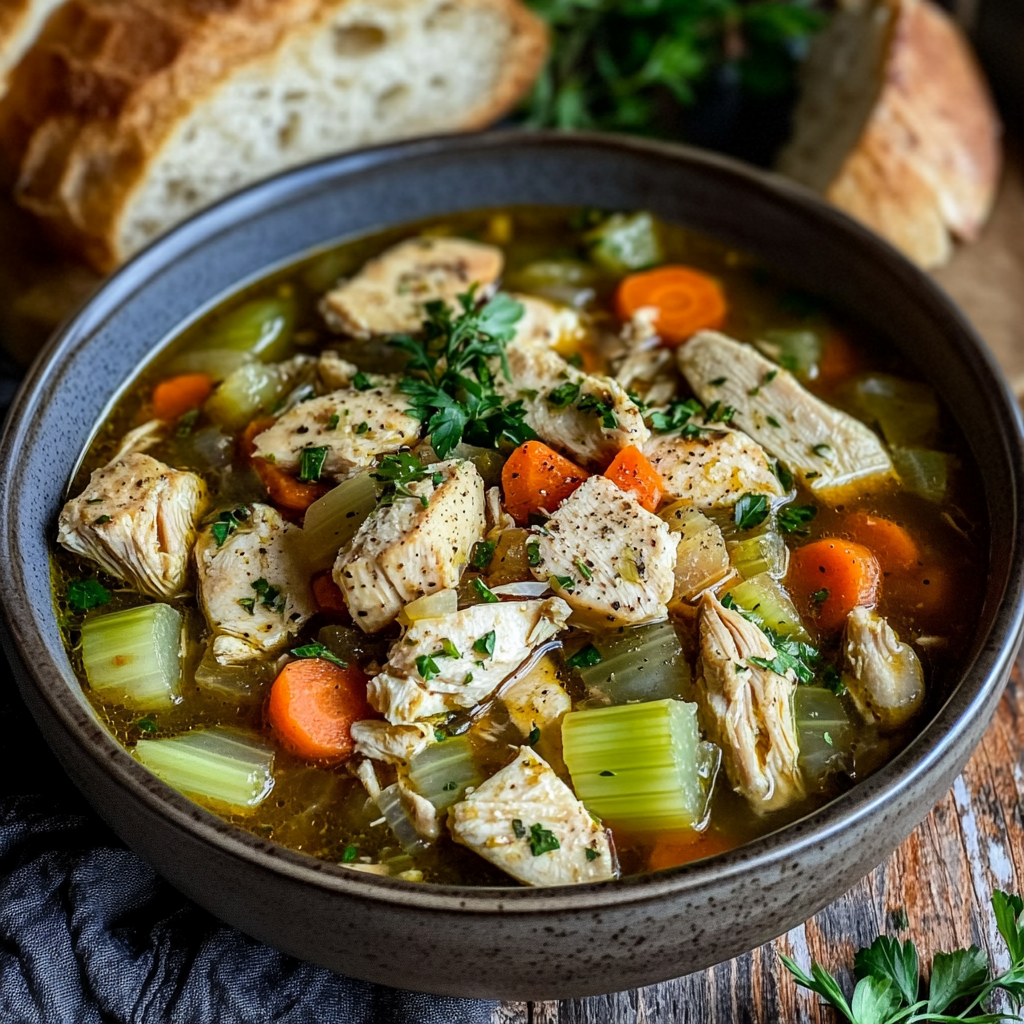Introduction
Welcome to the ultimate guide on crafting the perfect chicken vegetable soup recipe. This hearty and nutritious soup is a favorite among many, thanks to its rich flavors and versatility. Whether you’re a seasoned cook or a beginner, this comprehensive guide will walk you through everything you need to know to create a delicious pot of chicken vegetable soup. With its combination of tender chicken and an array of fresh vegetables, this soup offers a unique blend of textures and flavors that make it a comforting meal for any occasion.
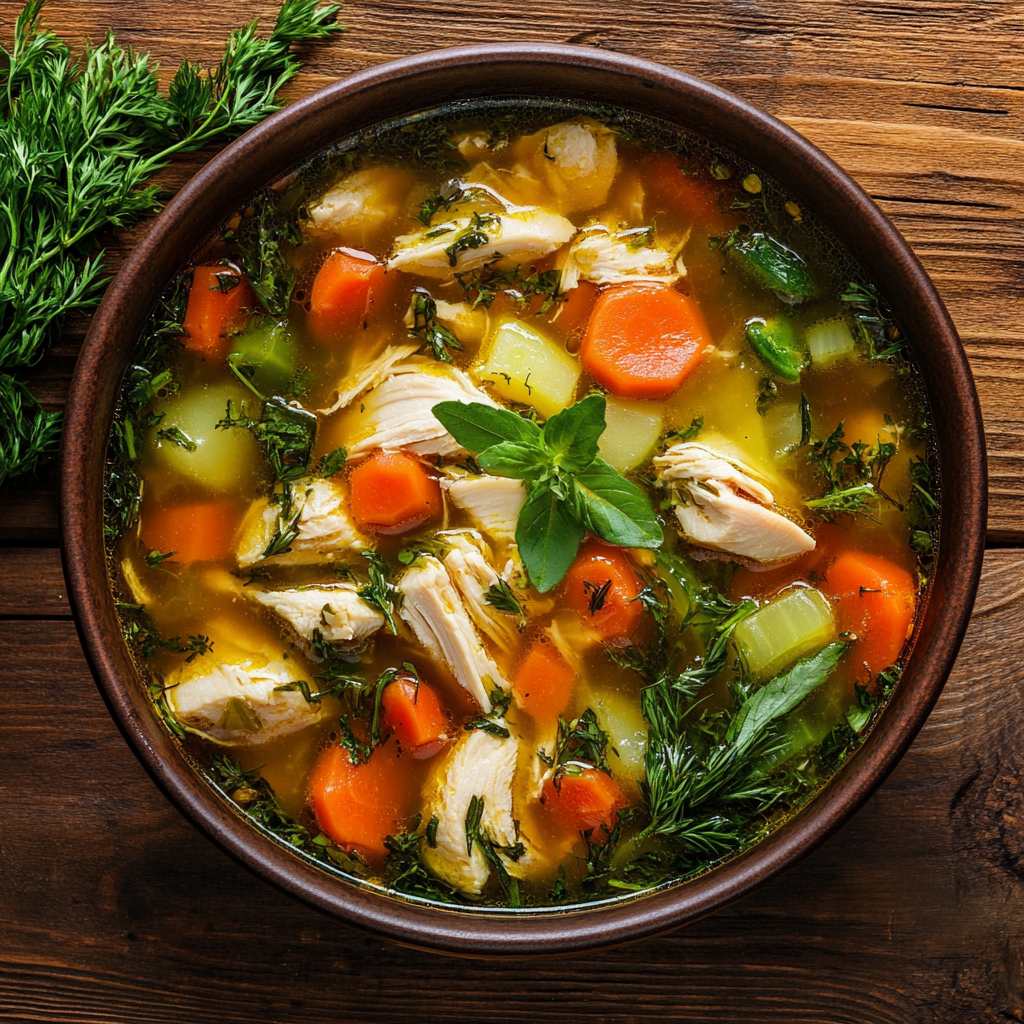
What is Chicken Vegetable Soup?
Chicken vegetable soup is a classic dish that combines tender chicken with a variety of fresh vegetables in a savory broth. This soup has been a staple in many households for generations, known for its hearty and comforting qualities. The combination of chicken and vegetables provides a high-protein meal that is both satisfying and nutritious. The soup’s origins can be traced back to traditional recipes that utilized simple ingredients for a wholesome meal. For a deeper dive into the historical significance of chicken soup, check out the History of Chicken Soup. Understanding the history of chicken soup can provide insight into the cultural significance of this dish and its evolution over time.
The chicken vegetable soup recipe is not only delicious but also packed with nutrients, making it an excellent choice for a wholesome meal. For more insights on the health benefits of incorporating chicken soup into your diet, explore this resource on the Health Benefits of Chicken Soup. Chicken soup is known for its ability to support immune function and provide essential vitamins and minerals.
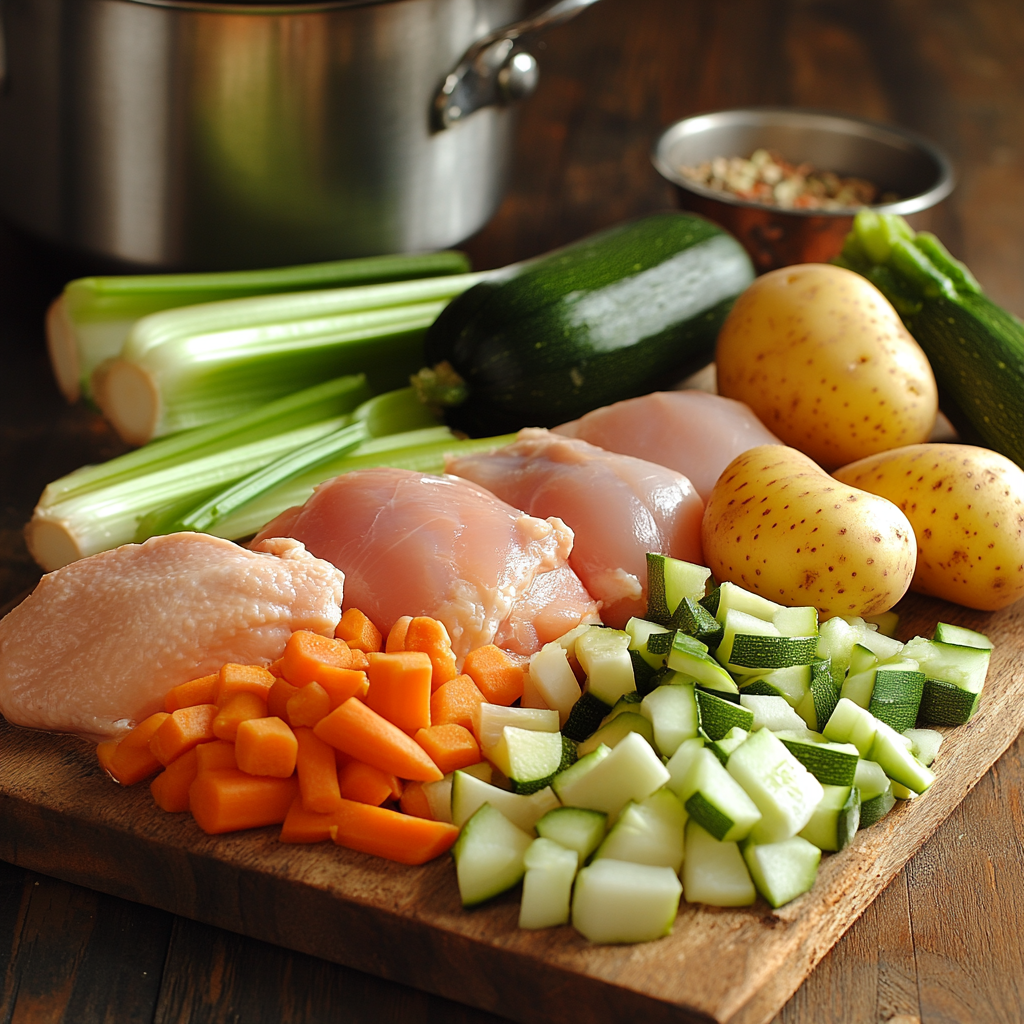
Ingredients
To create the perfect chicken vegetable soup, you’ll need a variety of ingredients that contribute to its rich flavor and nutritional content. Here’s what you’ll need:
-
Chicken:
- Breasts: Boneless, skinless chicken breasts are a lean option that cooks quickly and evenly. They are versatile and absorb the flavors of the soup well.
- Thighs: Boneless, skinless chicken thighs are slightly more flavorful due to their higher fat content. They remain tender and moist during cooking, making them an excellent choice for soups.
- Rotisserie Chicken: Using pre-cooked rotisserie chicken can save time and effort. Simply shred the meat and add it to the soup towards the end of cooking.
-
Vegetables:
- Carrots: Add a slight sweetness and a vibrant color to the soup. They are rich in beta-carotene and other vitamins.
- Celery: Provides a crisp texture and mild flavor. It’s a great source of fiber and vitamin K.
- Onions: Form the base of the soup’s flavor. They can be yellow, white, or red, depending on your preference.
- Potatoes: Add heartiness and substance to the soup. They absorb the flavors of the broth and other ingredients.
- Zucchini: A versatile vegetable that adds bulk and nutrition to the soup. It has a mild flavor that complements other ingredients.
- Green Beans: Provide a crisp texture and a vibrant green color. They are rich in vitamins and fiber.
- Spinach: Boosts the nutritional content with added greens. It’s rich in iron and other vitamins.
-
Aromatics:
- Garlic: Enhances the flavor profile with a subtle kick. It’s a versatile ingredient that adds warmth and depth to the soup.
- Onion: Forms the base of the soup’s flavor. It can be yellow, white, or red, depending on your preference.
- Bay Leaves: Add a subtle, aromatic flavor to the soup. They are typically removed before serving.
- Thyme: Provides a slightly minty, lemony flavor that complements the other ingredients.
- Oregano: Adds a warm, slightly sweet flavor to the soup. It pairs well with the other herbs and spices.
-
Broth:
- Chicken Broth: Forms the base of the soup, providing depth of flavor. You can use store-bought or homemade broth.
- Vegetable Broth: A great alternative for a vegetarian or vegan version of the soup. It provides a similar depth of flavor.
-
Seasonings:
- Salt: Enhances the flavors of the other ingredients. It’s essential for a well-rounded soup.
- Pepper: Adds a subtle heat and depth of flavor. You can use black or white pepper, depending on your preference.
- Italian Seasoning: A blend of herbs that adds complexity and depth to the soup’s flavor profile.
- Red Pepper Flakes: Add a touch of heat to the soup. You can adjust the amount to suit your preference.
-
Optional Add-ins:
- Pasta: Adds heartiness and substance to the soup. You can use any shape or size, depending on your preference.
- Rice: Absorbs the flavors of the broth and other ingredients. It’s a great way to stretch the soup and make it more filling.
- Tortellini: A type of filled pasta that adds heartiness and flavor to the soup. It pairs well with the chicken and vegetables.
- Beans: Add protein and fiber to the soup. You can use any variety, depending on your preference.
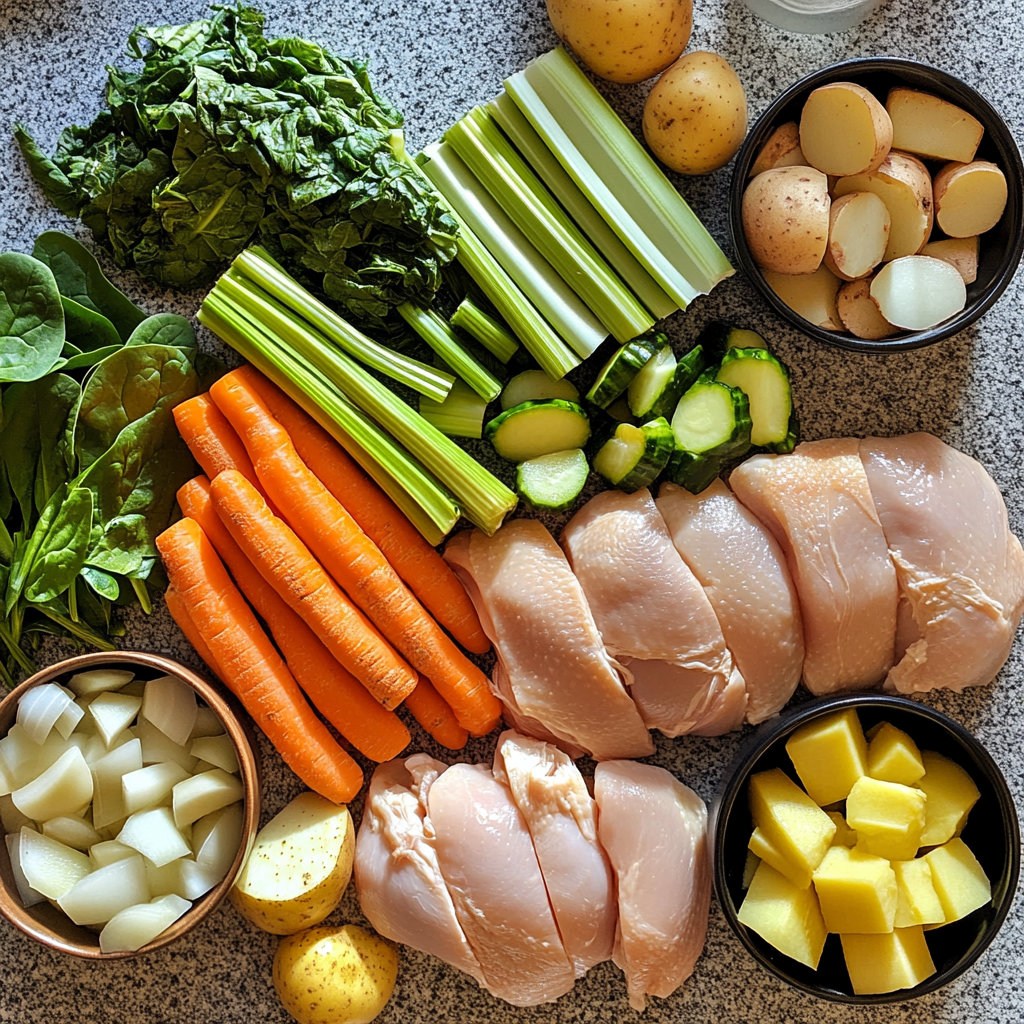
Preparation Tips
Preparing chicken vegetable soup involves a few key steps to ensure the best results:
-
Chopping Vegetables and Chicken: Cut the vegetables and chicken into bite-sized pieces for even cooking. This ensures that all the ingredients cook uniformly and blend well together in the soup.
- Vegetables: Aim for uniform sizes to ensure even cooking. For example, dice carrots, celery, and onions into similar-sized pieces.
- Chicken: Cut into bite-sized pieces or strips, depending on your preference. Ensure the pieces are similar in size for even cooking.
-
Sautéing Aromatics: Sauté the aromatics like garlic and onions in a bit of olive oil to release their flavors. This step is crucial for building the soup’s flavor base.
- Heat a small amount of olive oil in your pot over medium heat.
- Add the diced onions and cook until they are translucent.
- Add the minced garlic and cook for an additional 30 seconds to 1 minute, until fragrant.
-
Preparing Broth: Choose a high-quality chicken or vegetable broth for the best flavor. You can also use homemade broth for an even richer taste.
- Store-Bought Broth: Look for low-sodium varieties to control the salt content of your soup.
- Homemade Broth: If you have the time, making your own broth can enhance the flavor of your soup.
- Bouillon Cubes: These can be used to enhance the flavor of store-bought or homemade broth.

Cooking Methods
There are several methods to cook chicken vegetable soup, each with its own advantages:
-
Stovetop Method:
- Instructions: Cook the chicken and vegetables together in a large pot on the stovetop.
- Heat a small amount of olive oil in your pot over medium heat.
- Add the chicken and cook until it’s no longer pink on the outside.
- Add the vegetables and cook for a few minutes until they begin to soften.
- Pour in the broth and bring to a boil.
- Reduce the heat to low, cover the pot, and let the soup simmer for 45 minutes until the chicken is cooked through and the vegetables are tender.
- Advantages: This method allows for easy monitoring and adjustment of seasonings. Cooking on the stovetop gives you more control over the cooking process, allowing you to adjust the heat and stir the soup as needed.
- Instructions: Cook the chicken and vegetables together in a large pot on the stovetop.
-
Slow Cooker Method:
- Instructions: Combine all ingredients in a slow cooker.
- Place the chicken, vegetables, broth, and seasonings in the slow cooker.
- Cook on low for 6-8 hours.
- If you prefer, you can cook on high for 3-4 hours.
- Advantages: This method is convenient for busy days and results in a rich, flavorful soup. The slow cooker method is ideal for those who want to set it and forget it, letting the soup cook slowly throughout the day.
- Instructions: Combine all ingredients in a slow cooker.
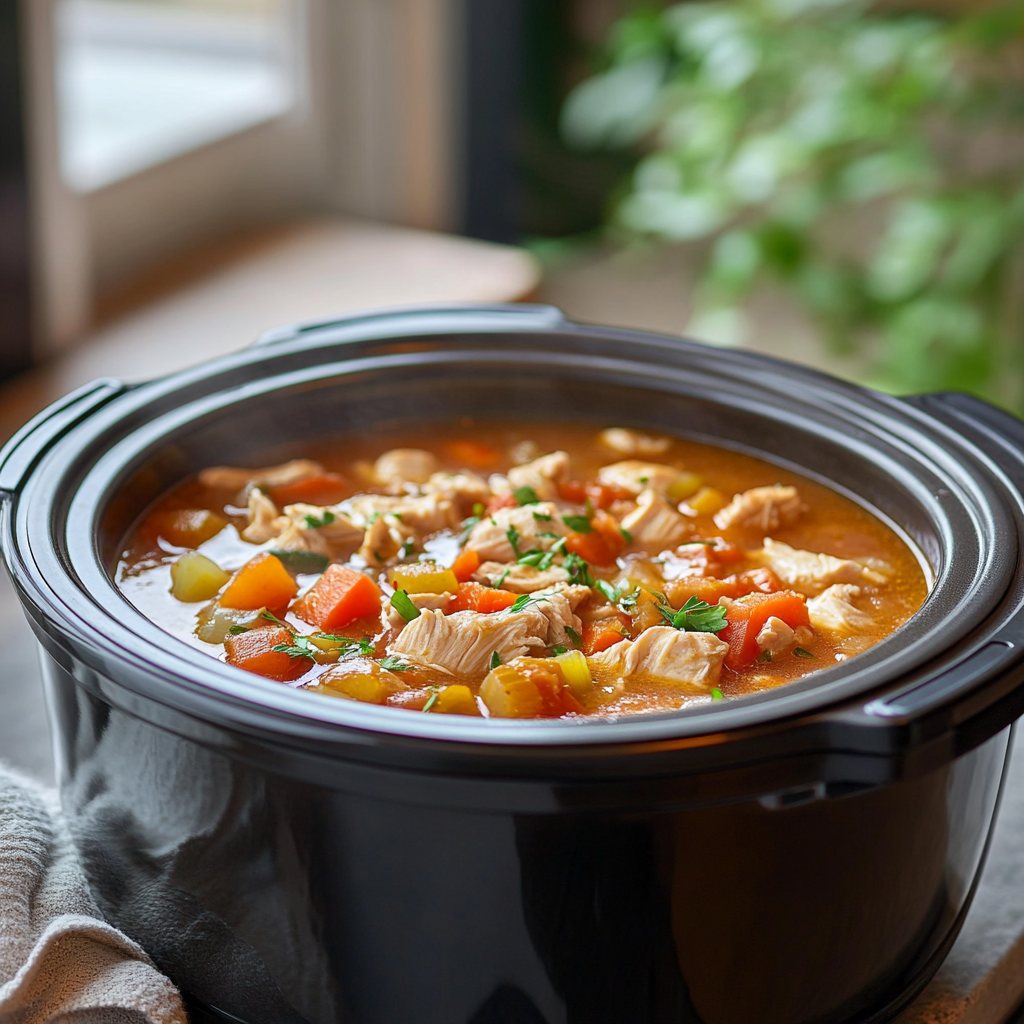
-
Instant Pot Method:
- Instructions: Cook the soup in an Instant Pot for a quick and efficient meal.
- Use the sauté function to cook the aromatics and brown the chicken.
- Add the vegetables, broth, and seasonings.
- Seal the Instant Pot and pressure cook for 30 minutes.
- Allow the pressure to release naturally for 10 minutes, then manually release any remaining pressure.
- Advantages: This method is ideal for those short on time but still want a homemade meal. The Instant Pot method significantly reduces cooking time, making it a great option for busy individuals.
- Instructions: Cook the soup in an Instant Pot for a quick and efficient meal.
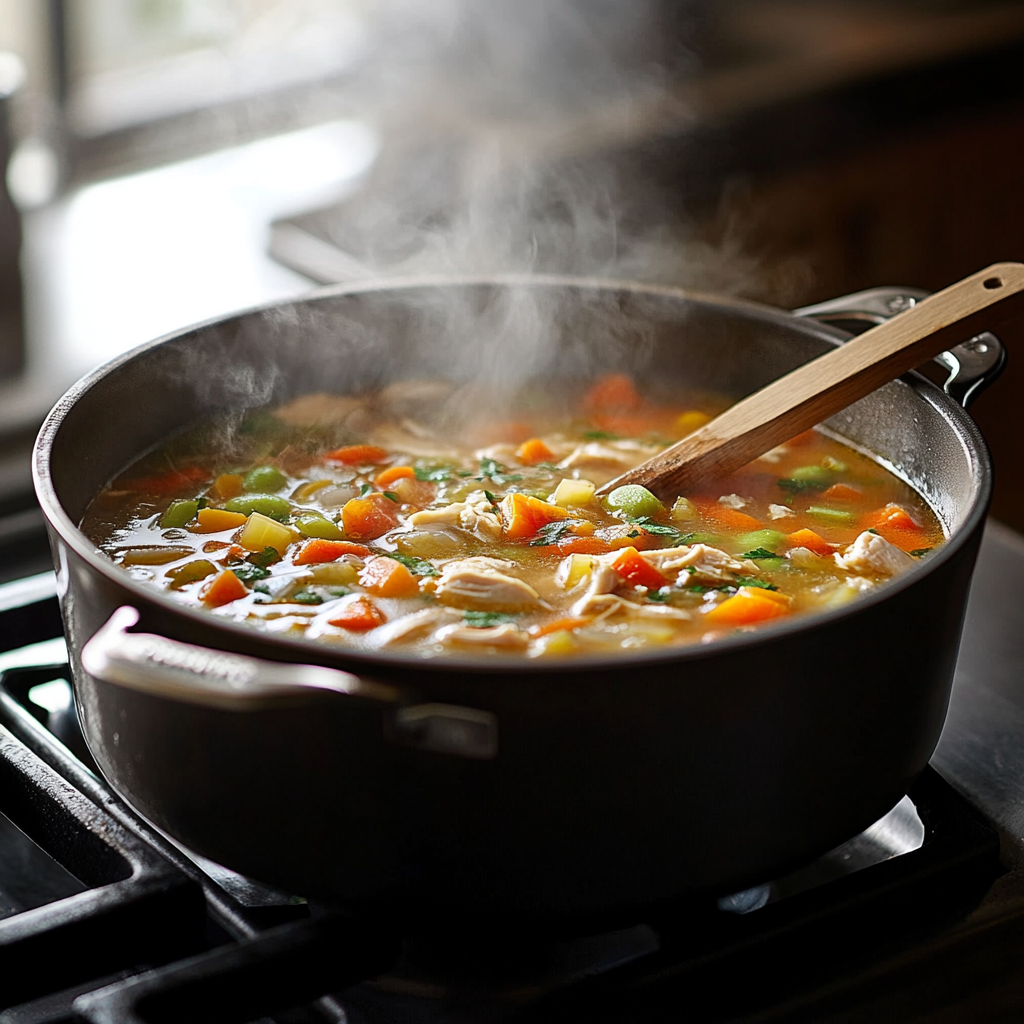
-
Dutch Oven Method:
- Instructions: Cook the soup in a Dutch oven for even heat distribution.
- Follow the same steps as the stovetop method, but use a Dutch oven instead of a regular pot.
- The heavy-duty construction of a Dutch oven ensures even heat distribution and prevents hot spots.
- Advantages: This method is great for achieving a consistent cooking temperature and preventing hot spots. The Dutch oven’s heavy-duty construction ensures even heat distribution, making it an excellent choice for cooking soups.
- Instructions: Cook the soup in a Dutch oven for even heat distribution.
Seasoning and Flavor Enhancements
To enhance the flavor of your chicken vegetable soup, consider the following tips:
-
Herbs and Spices: Use a blend of herbs and spices such as bay leaves, thyme, oregano, salt, and pepper. These ingredients add depth and complexity to the soup’s flavor profile. Experiment with different herbs and spices to find the combination that suits your taste.
- Fresh Herbs: If available, use fresh herbs for a more vibrant flavor. Add them towards the end of cooking to preserve their flavor.
- Dried Herbs: These can be added at the beginning of cooking to allow their flavors to meld with the other ingredients.
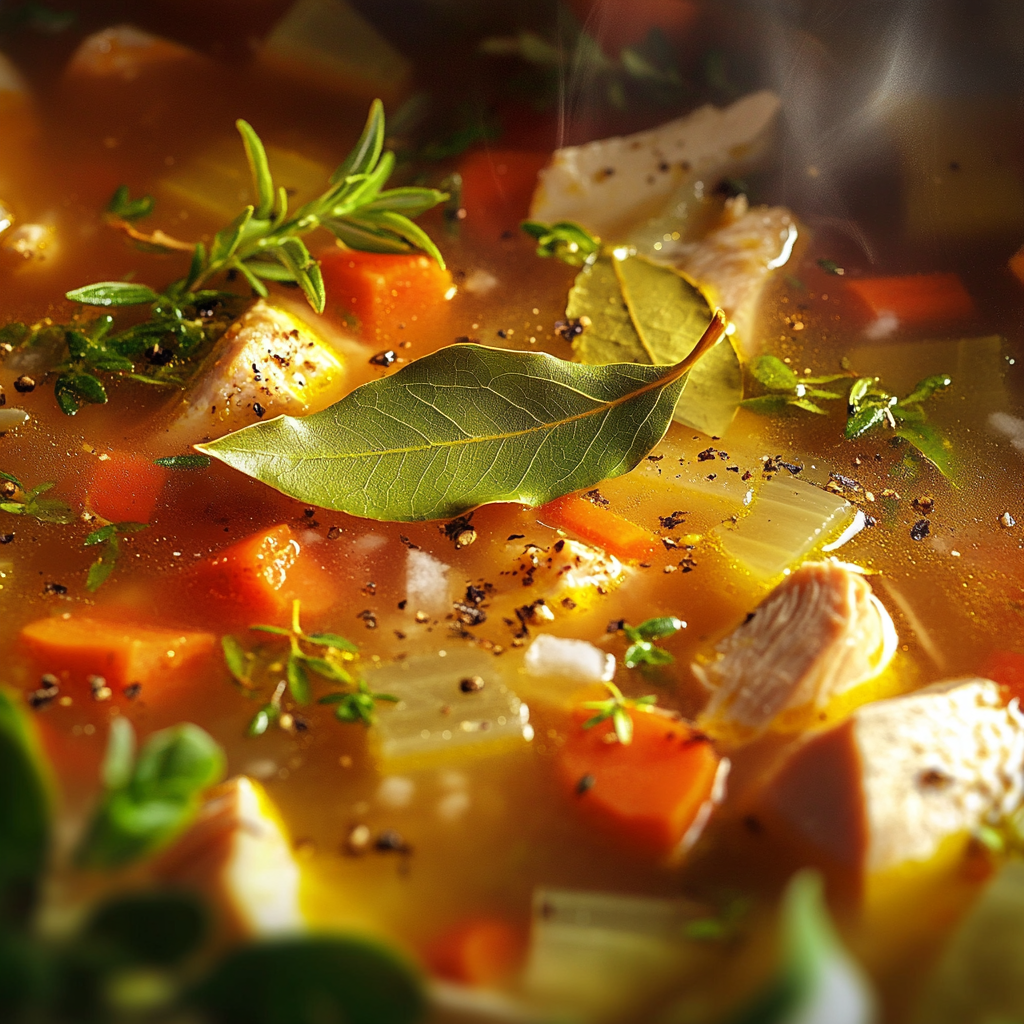
-
Umami Ingredients: Add soy sauce or miso paste for a depth of flavor. Umami ingredients provide a savory richness that enhances the overall taste of the soup. These ingredients can be added in small amounts and adjusted to taste.
- Soy Sauce: Add a small amount to the broth for a savory flavor. Be mindful of the sodium content and adjust the salt in your recipe accordingly.
- Miso Paste: Dissolve a small amount in some of the broth before adding it to the soup. This will provide a rich, umami flavor.
-
Customizing the Soup: Adjust the seasonings to suit your personal taste. Some people prefer a more robust flavor, while others enjoy a milder soup. Don’t be afraid to experiment with different seasonings and ingredients to make the soup your own.
- Spicy: Add more red pepper flakes or a pinch of cayenne pepper for a spicier soup.
- Herbaceous: Add more fresh herbs, such as parsley or basil, for a fresher flavor.
- Creamy: Stir in a splash of heavy cream or coconut milk for a creamier texture.
Serving Suggestions
Chicken vegetable soup is best enjoyed with a side of crusty bread or a fresh salad. Garnish with chopped parsley or grated cheese for added flavor. Serving the soup with complementary sides can elevate the meal and provide a well-rounded dining experience.
- Bread: Crusty bread, dinner rolls, or garlic bread are excellent choices for soaking up the broth and complementing the soup.
- Salad: A simple green salad with a tangy vinaigrette can provide a refreshing contrast to the hearty soup.
- Garnishes: Chopped fresh parsley, grated Parmesan cheese, or a drizzle of olive oil can enhance the flavor and presentation of the soup.
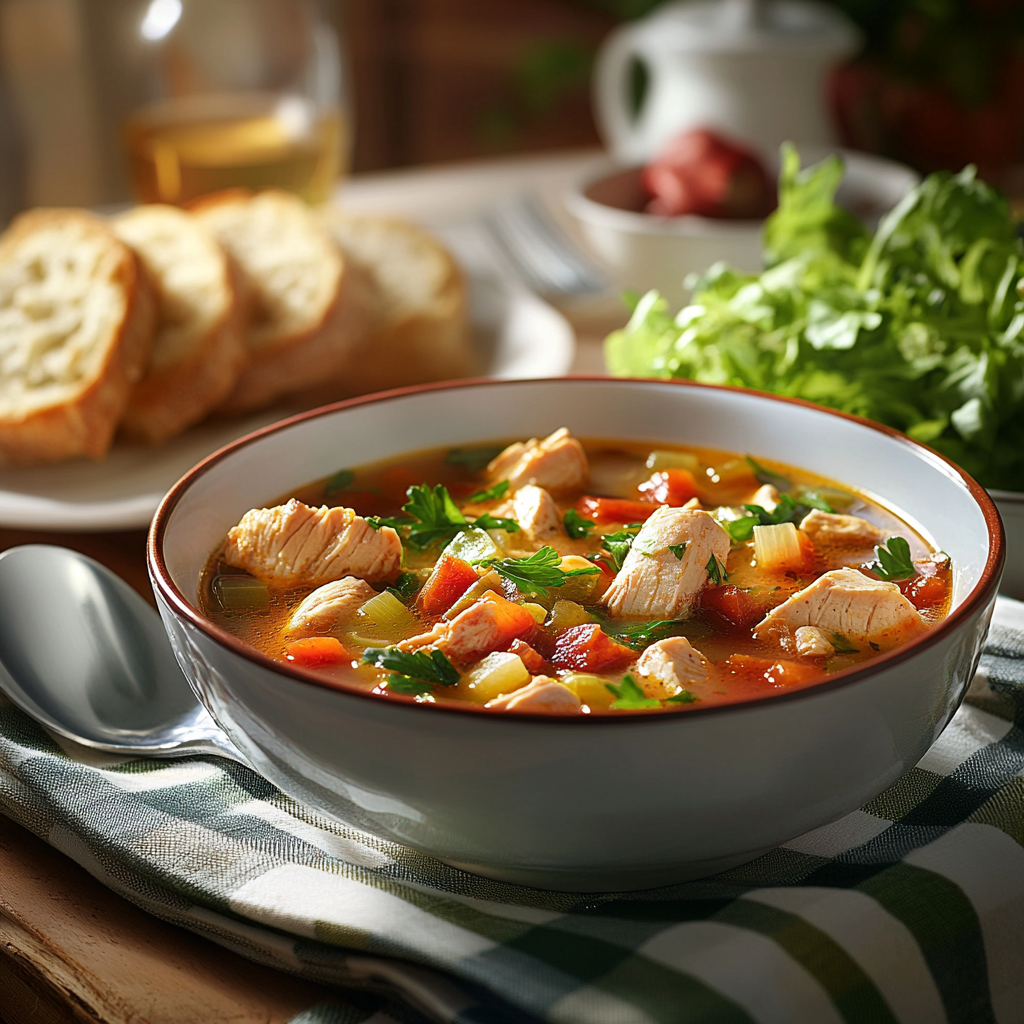
Storage and Reheating
Store leftover chicken vegetable soup in an airtight container in the refrigerator for up to 5 days. You can also freeze the soup for up to 3 months. Reheat on the stovetop or in the microwave. Proper storage and reheating techniques ensure that the soup retains its flavor and texture. When reheating, add a small amount of water or broth to the soup if it has thickened too much.
- Refrigerating: Allow the soup to cool before transferring it to an airtight container. Store in the refrigerator for up to 5 days.
- Freezing: Transfer the cooled soup to a freezer-safe container. Freeze for up to 3 months. Thaw overnight in the refrigerator before reheating.
- Reheating: Reheat the soup on the stovetop over medium heat, stirring occasionally. Alternatively, reheat individual portions in the microwave.
Variations of Chicken Vegetable Soup
-
Vegetarian/Vegan Version: Substitute the chicken with vegetables or plant-based protein for a meat-free option. This variation is perfect for those following a vegetarian or vegan diet. Adding extra vegetables or plant-based protein can enhance the soup’s nutritional content and flavor.
- Vegetables: Add more of your favorite vegetables, such as bell peppers, mushrooms, or sweet potatoes.
- Plant-Based Protein: Use chickpeas, lentils, or tofu as a substitute for chicken.
-
Spicy Version: Add chili peppers or hot sauce for a kick. For those who enjoy a bit of heat, adding chili peppers or hot sauce can provide the perfect level of spice. Adjust the amount of heat to suit your preference.
- Chili Peppers: Add diced jalapeños or red pepper flakes for a spicy kick.
- Hot Sauce: Stir in your favorite hot sauce to taste.
-
Creamy Version: Blend a portion of the soup for a creamier texture. Blending a portion of the vegetables can create a creamy base for the soup, providing a smooth and velvety texture. This variation is ideal for those who prefer a smoother soup consistency.
- Blending: Use an immersion blender to blend a portion of the vegetables and broth until smooth. Stir the blended mixture back into the soup.
- Cream: Stir in a splash of heavy cream or coconut milk for added richness.
-
Low-Sodium Version: Use low-sodium broth and seasonings. For those watching their sodium intake, using low-sodium broth and seasonings can help reduce the overall sodium content of the soup.
- Broth: Use low-sodium chicken or vegetable broth.
- Seasonings: Use herbs and spices to flavor the soup instead of relying on salt.
FAQs
-
Can I use canned vegetables instead of fresh?
- Yes, but cooking time will be reduced. Using canned vegetables can save time and effort, as they are already cooked and ready to use. Simply drain and rinse the canned vegetables before adding them to the soup. Keep in mind that canned vegetables may have a softer texture and slightly different flavor than fresh vegetables.
-
How can I thicken the soup?
- Blend a portion of the vegetables or add a cornstarch slurry. Thickening the soup can enhance its heartiness and make it more satisfying. Blending a portion of the vegetables or adding a cornstarch slurry are effective methods for achieving a thicker consistency.
- Blending: Use an immersion blender to blend a portion of the vegetables and broth until smooth. Stir the blended mixture back into the soup.
- Cornstarch Slurry: Mix equal parts cornstarch and water, then stir the mixture into the soup. Cook for a few minutes until the soup thickens.
- Blend a portion of the vegetables or add a cornstarch slurry. Thickening the soup can enhance its heartiness and make it more satisfying. Blending a portion of the vegetables or adding a cornstarch slurry are effective methods for achieving a thicker consistency.
-
Can I make this soup without chicken?
- Yes, use vegetable broth and add extra vegetables or plant-based protein. For a vegetarian or vegan version, using vegetable broth and adding extra vegetables or plant-based protein can provide a similar depth of flavor without the need for chicken.
- Vegetables: Add more of your favorite vegetables, such as bell peppers, mushrooms, or sweet potatoes.
- Plant-Based Protein: Use chickpeas, lentils, or tofu as a substitute for chicken.
- Yes, use vegetable broth and add extra vegetables or plant-based protein. For a vegetarian or vegan version, using vegetable broth and adding extra vegetables or plant-based protein can provide a similar depth of flavor without the need for chicken.
-
How long does it take to cook chicken vegetable soup?
- Depends on the method: stovetop (45 min), slow cooker (6-8 hours), Instant Pot (30 min). The cooking time varies depending on the method used. Choose the method that best fits your schedule and preferences.
- Stovetop: 45 minutes of active cooking time, plus additional time for preparation.
- Slow Cooker: 6-8 hours of hands-off cooking time, plus additional time for preparation.
- Instant Pot: 30 minutes of active cooking time, plus additional time for preparation and pressure release.
- Depends on the method: stovetop (45 min), slow cooker (6-8 hours), Instant Pot (30 min). The cooking time varies depending on the method used. Choose the method that best fits your schedule and preferences.
-
Can I add other vegetables to the soup?
- Yes, add spinach, kale, or sweet potatoes for extra nutrition. Incorporating additional vegetables can boost the soup’s nutritional content and add variety to the flavor profile. Experiment with different vegetables to find the combination that you enjoy the most.
- Leafy Greens: Add spinach, kale, or Swiss chard for added nutrition and color.
- Root Vegetables: Add sweet potatoes, turnips, or parsnips for heartiness and substance.
- Cruciferous Vegetables: Add broccoli, cauliflower, or Brussels sprouts for added nutrition and texture.
- Yes, add spinach, kale, or sweet potatoes for extra nutrition. Incorporating additional vegetables can boost the soup’s nutritional content and add variety to the flavor profile. Experiment with different vegetables to find the combination that you enjoy the most.
Conclusion
Chicken vegetable soup is a versatile and delicious dish that is perfect for any occasion. Whether you prefer a classic recipe or a unique variation, this guide provides all the information you need to create a hearty and flavorful pot of soup. Experiment with different ingredients and cooking methods to find your favorite version. Happy cooking!
By following this comprehensive guide, you can create a delicious and nutritious chicken vegetable soup that is sure to impress. Whether you are cooking for yourself or sharing with friends and family, this soup is a comforting and satisfying meal that everyone will enjoy. The chicken vegetable soup recipe is more than just a meal; it’s an experience that brings warmth and satisfaction to the table. With its adaptability and endless possibilities, you can make it your own and enjoy a comforting bowl of soup anytime.
